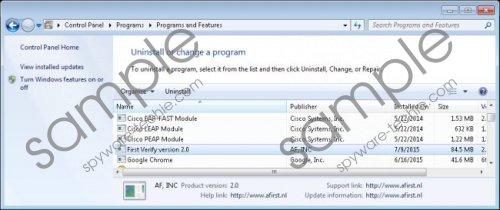Do you know what First Verify is?
You may not even know First Verify is on your computer because this application does not get installed individually. It is an adware program that is used as an adware helper by other applications. This means that when you remove First Verify from your system, you have to get rid of all unwanted programs. That is why investing in a licensed antispyware tool is important, especially if you are not an experienced computer user. You have to take all the means possible to protect your system from harm and terminate all the potentially harmful files and applications.
This program supposedly boasts of an official website, but when we tried accessing afirst.nl, we found that the page does not work. Thus, a direct application download is out of question. This only proves that First Verify comes in software packages. If you download programs from third-party websites on a regular basis, there is a good chance that you install First Verify and other similar apps along with the program you wanted to have. Third-party installers often contain at least several freeware apps, and if you go through the installation process without checking all the setup steps, it is only natural that potentially unwanted and possibly harmful adware applications enter your PC as well. First Verify screenshot
First Verify screenshot
Scroll down for full removal instructions
First Verify is sometimes identified as a Trojan by various computer security tools, but it simply means that the application could be exploited by cyber criminals for their objectives. Since First Verify functions as an adware helper, it means that it can perform a variety of functions. It all depends on what the program it “helps” wants it to do. Consequently, First Verify could collect information on your web browsing habits. It might connect to a remote server to upload the collected data for online marketing purposes. What’s more, First Verify might also generate customized commercial ads that would appear on your browser out of nowhere.
The bottom line is that First Verify should not be tolerated, as there is no telling what this program might end up doing. Although you can remove First Verify via Control Panel, it might not be enough to protect your computer from harm. Keeping in mind that some security programs identify First Verify as a Trojan component, you should definitely run a full system scan with a licensed antispyware tool once you have removed First Verify manually.
Should you detect any unfamiliar or potentially malicious programs during the full system scan, you have to delete them all at once. Unlike First Verify, some programs might be impossible to terminate via Control Panel, and this is where the automated malware removal tool comes handy. Not to mention that once your computer is safe and clean, the security program of your choice will ensure that your system remains protected from similar intruders 24/7.
If you think that you need further assistance with First Verify removal, you can always leave us a comment. Our team will respond as soon as possible. Your computer security depends a lot on your safe web browsing habits, but it always a good idea to rely on professional help!
How to Remove First Verify
Windows 8 & Windows 8.1
- Drag the mouse cursor to the bottom right of your screen.
- Click Settings on the Charm bar and go to Control Panel.
- Open Uninstall a program and remove First Verify.
Windows Vista & Windows 7
- Open the Start menu and click Control Panel.
- Go to Uninstall a program and remove First Verify.
Windows XP
- Click the Start button and navigate to Control Panel.
- Double-click Add or remove programs and uninstall First Verify.
In non-techie terms:
First Verify is an adware helper application that may cause serious computer security issues. You have to remove First Verify immediately to avoid undesirable consequences. Do yourself a favor and run a full system scan with the SpyHunter free scanner to locate all the dangerous files and applications. The sooner you get rid of all the potential system threats, the better.
